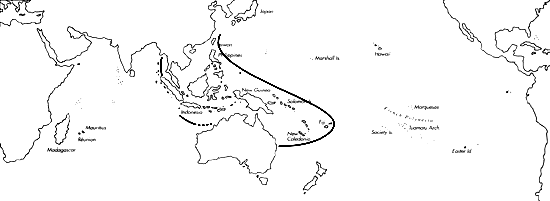
Skip Navigation Links
View access keys for this site.

Range: W. Thailand to Micronesia, Taiwan to Queensland; probably also Seychelles.
Description: Moderately small to medium-sized, moderately solid. Last whorl usually ventricosely conical to ovate; outline variably convex. Shoulder angulate to almost rounded. Spire of moderate height, outline straight to slightly convex. Larval shell multispiral, maximum diameter about 0.7 mm. Teleoconch sutural ramps flat to concave, with 2 increasing to 4-6 spiral grooves. Last whorl with widely spaced spiral ribs at base.
| Shell Morphometry | ||
|---|---|---|
| L | 25-40 mm | |
| RW | 0.10-0.27 g/mm | |
| RD | 0.61-0.67 | |
| PMD | 0.71-0.80 | |
| RSH | 0.12-0.19 | |
Ground colour pale grey to pale tan. Last whorl with olive or brown axial clouds, emphasized by bordering bluegrey background clouds, fusing into an interrupted or continuous spiral band on each side of centre. Spiral rows of alternating brown to black and white dots and dashes extend from base to shoulder. In some specimens, clouds absent from last whorl. Larval whorls pink to orange. Late sutural ramps with tan to olive radial streaks and blotches. Aperture white to bluish white.
Dorsum of foot beige medially, with tan radial streaks; a dotted black pre-marginal line merges into a prominent saddle-shaped or irregular black blotch near anterior margin; marginal zone either alternating black and white or buff to dark orange variably mottled with brown laterally and posteriorly; white spots sometimes occur near anterior corners. Sole of foot grey to buff, with fewer tan streaks than dorsum. Rostrum buff to pale orange, occasionally mottled with brown dorsally. Tentacles white to buff, sometimes tipped with brown. Siphon white or tan, mottled darker brown dorso-laterally; tip buff to pale orange (Pl. 75, fig. 29; Pl. 79, Third row, right) (Chaberman, pers. comm., 1981 ; Kohn, unpubl. observ.).
Habitat and Habits: Intertidal and upper subtidal, on muddy sand. Sympatric with C. achatinus and C. monachus in New Britain (Richards, 1989).
In Palau, egg diameter of 224 ┬Ám suggests a minimum pelagic period of about 21 days (Perron & Kohn, 1985, as "C. nigropunctatus").
Discussion: C. achatinus is larger (40-82 mm), often with a narrower last whorl (RD 0.54-0.69) and less regular colour pattern, and with distinctly tuberculate early postnuclear whorls. C. monachus is also larger, blue clouds and blotches dominate its last whorl, and its larval shell is brown. For comparison with C. catus, see the Discussion of
that species.
C. achatinus is larger (40-82 mm), often with a narrower last whorl (RD 0.54-0.69) and less regular colour pattern, and with distinctly tuberculate early postnuclear whorls. C. monachus is also larger, blue clouds and blotches dominate its last whorl, and its larval shell is brown. For comparison with C. catus, see the Discussion of
that species.
The type figure of C. striolatus depicts a colour form lacking olive clouds on the last whorl (Pl. 15, Fig. 17). C.
Striolatus has been an enigmatic species, often assigned to C. magus, C. achatinus, or C. monachus. It has also been considered a valid species, under the names "C. ranunculus Hwass" (a synonym of C. achatinus), "C. vinctus A. Adams" (a synonym of C. monachus), "C. nigropunctatus Sowerby III" (a variant of C. catus), and "C. decurtatus Dautzenberg" (a synonym of C. striolatus). Coomans et al. (1985b) substantiated the validity and established the correct name.

C. striolatus range map
This section contains verbatim reproductions of the accounts of 316 species of Conus from the Indo-Pacific region, from Manual of the Living Conidae, by R÷ckel, Korn and Kohn (1995). They are reproduced with the kind permission of the present publisher, Conchbooks.
All plates and figures referred to in the text are also in R÷ckel, Korn & Kohn, 1995. Manual of the Living Conidae Vol. 1: Indo-Pacific Region.
The range maps have been modified so that each species account has it own map, rather than one map that showed the ranges of several species in the original work. This was necessary because each species account is on a separate page on the website and not confined to the order of accounts in the book.
Return to framed version (returns to search page)